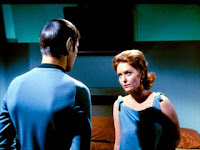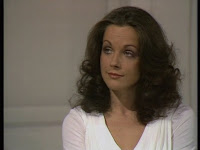 With #18, Haney and Cardy are gone, and it's like going from day to night. The 60s lingo is gone. The truly mental Silver Age concepts are gone. And the omnipresent narrative voice shuts up once in a while and lets the art tell the story. In fact, Bill Draut paces Len Wein & Marv Wolfman's story in comparatively modern fashion. Check out this scene, for example:
With #18, Haney and Cardy are gone, and it's like going from day to night. The 60s lingo is gone. The truly mental Silver Age concepts are gone. And the omnipresent narrative voice shuts up once in a while and lets the art tell the story. In fact, Bill Draut paces Len Wein & Marv Wolfman's story in comparatively modern fashion. Check out this scene, for example: He also makes use of some interesting "camera" angles, though not always with dramatic effect. Consider the following panel:
He also makes use of some interesting "camera" angles, though not always with dramatic effect. Consider the following panel: What the hell?!? It's like Robin left the shot before his cue. I get it, but I can't dance to it, y'know?
What the hell?!? It's like Robin left the shot before his cue. I get it, but I can't dance to it, y'know?But for all the modernity of the art and even the story - the Titans get to be a lot more "angsty", which is short hand for "teen psychology" - it's still got a lame-ass, over-the-top villain, and that spells Titans Go! André LeBlanc is the world's greatest jewel thief, and though he seems to have superhuman abilities (unless the Titans are still wearing the Mad Mod's depowering textiles), he couldn't be bothered to pick a codename.
Not that he has anything to really worry about. If he needs to hide out, he should really come to my region in Southeastern New Brunswick. There are at least 23 André LeBlancs in the phone book!
 I know at least 2 of them and they're really sweet guys.
I know at least 2 of them and they're really sweet guys.Anyway, the story goes like this: The Titans are teamed up with Soviet super-teen Starfire (now known as Red Star), who they don't really get along with to protect some crown jewels from LeBlanc. The master thief puts each Titan in a death trap and is about to escape when it's revealed that Starfire has freed each one, and then Robin beats LeBlanc's French-accented ass into submission. Heyyy, let's all be friends, ok commie?
 Hate to break it to you, Russkie, but ideologies are abstractions. They can't ever "turn to dust". Your country's economy, however...
Hate to break it to you, Russkie, but ideologies are abstractions. They can't ever "turn to dust". Your country's economy, however...Oh what's this? Research tells me André LeBlanc actually appeared on the cartoon show? I really have to start watching those. Especially now that I'm done with this Showcase Presents. Need my Haneyesque dose of Titans, don't I? Well, don't I? DON'T I??!?









 This cover in fact yielded one of the best improvs of the game, with my good friend Josée playing the title role brilliantly. Come to think of it, she had a great game over all, also playing this chick as a phone sex operator:
This cover in fact yielded one of the best improvs of the game, with my good friend Josée playing the title role brilliantly. Come to think of it, she had a great game over all, also playing this chick as a phone sex operator:






































